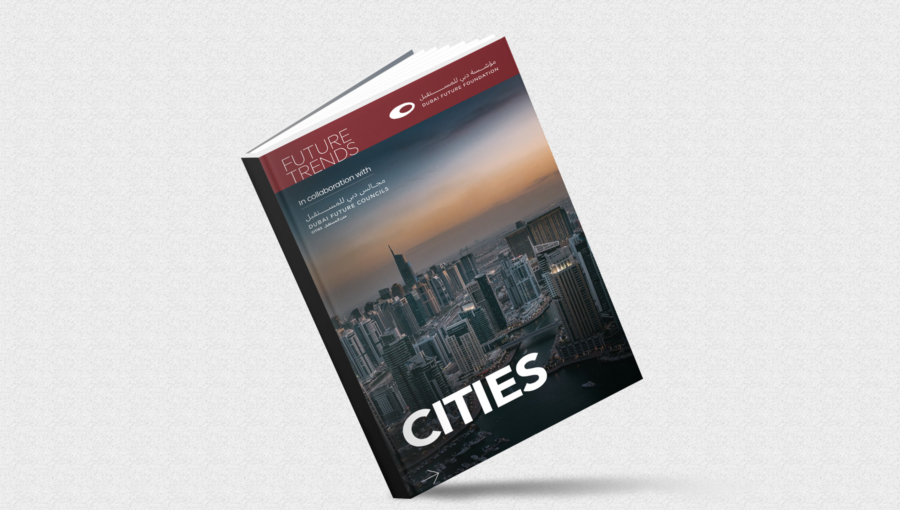Dubai Future Foundation (DFF) launched The Future of Cities report in partnership with the Dubai Future Council on Future Cities. The report predicts that city density will become an increasingly important issue, given that around two-thirds of the people in the Middle East and North Africa currently live in cities, and the urban population of the region is expected to double by 2040.
DFF’s Future Trends series, The Future of Cities highlights the most prominent impacts of the COVID-19 pandemic on the nature of urban life, which is characterized by the intensity of movement between residential, commercial and social areas, and the required changes in urban planning standards and infrastructure in the ‘new normal’.
Speaking on the report launch, His Excellency Eng Dawood Abdulrahman Al Hajri, Director General of Dubai Municipality and Chairman of the Dubai Future Council on Future Cities, said: “At the Dubai Future Council on Future Cities, we implement the vision of our wise leadership to boost our competitiveness in building better future cities for the upcoming generations. In addition, we enrich various sectors with creative ideas, contributing to the highest levels of innovation and excellence.”
He added: “It is crucial to develop initiatives that help strengthen Dubai’s position as an international city and mitigate the impact of COVID-19 on infrastructure, urban planning, the environment, and the methods of managing and governing future cities. Our joint report with DFF presents an overview of global trends, technological transformation, advancements in urban economics and the lifestyles of future cities, analyzes current situation, and identifies opportunities for the future of Dubai, which will be human-centric. It also explores the shift the world is witnessing due to the COVID-19 outbreak, and assists decision makers in foreseeing changes that will serve the community. Lastly, the report supports strategic and effective planning based on best practices and international studies.”
His Excellency Khalfan Belhoul, CEO of DFF, stressed the significance of stakeholder cooperation in anticipating key changes in various sectors and preparing for the upcoming challenges by developing comprehensive future scenarios to enhance readiness, align national social and economic development plans, and benefit from global case studies in designing the future.
He added: “The next stage will witness radical changes in the urban planning system for future cities. This report represents the culmination of the efforts of DFF and the Dubai Future Council on Future Cities to forecast the most important trends in vital sectors related to this field, and provides recommendations for infrastructure development based on solid scientific foundations to mitigate the challenges of the future.”
The report places high value on smart initiatives and data-gathering efforts. Increasing the volume of city-level data can help governments implement smart regulations and infrastructure that allow residents to inhabit and navigate urban centers in a healthier and more sustainable way. There is scope for regularly updated data to be collected in areas such as noise, air quality, energy consumption and mobility. For example, in mobility, smart sensors and data-sharing agreements can enable local government entities to monitor vehicle movement, pedestrian flow and car park occupancy. Such detailed data streams allow authorities and enterprises to make more informed and sustainable decisions during the current crisis and in the future, creating more connected and livable cities.
Innovative technologies reduce the need for manual human operation. These include self-cleaning materials and automated touchless systems, such as automatic doors, voice-activated elevators, cell phone-controlled hotel room entry, hands-free light switches and temperature controls, automated luggage tags, and advanced airport check-in and security.
According to the report, urban parks and green areas play a critical role, as they provide residents with safe public spaces where they can observe social distancing. A holistic approach to planning that allows spatial distancing and combines grey, green and blue infrastructure will support public health. Moreover, large open spaces within urban areas can help cities implement emergency and evacuation protocols.
The report recommends updating building regulations and specifications to safeguard occupants’ health and wellbeing. This involves mechanical and architectural requirements, such as increasing natural light and improving air filtration. It also explores using construction elements previously reserved for health care in public spaces, including medical-grade surfaces and ventilation systems that remove potentially contaminated air, and large-scale adoption of sensor technologies and health-screening devices, such as thermometers, in cities.
Furthermore, the report re-imagines workplaces to integrate virtual and traditional work, and strike a balance between individual concentration and productive collaboration. The objective for architects is to design open spaces that encourage people to spread out and have less contact with each other while still working together.
Challenges faced by public transport and mobility in general due to COVID-19 provide new impetus to authorities to rethink the way citizens live and move around, and the associated planning issues. For example, as fewer people have been commuting into city centers, several cities around the world are now working towards creating physically closer urban communities in which residents can reach neighborhood shops and facilities that serve all their needs within 15 minutes.
